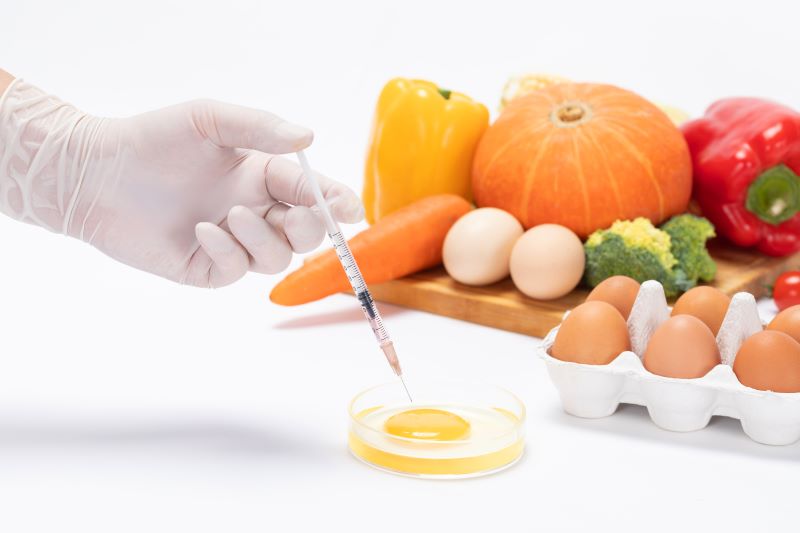What is Intentional Adulteration, its Types & How to Detect?

Intentional adulteration, a concerning issue in food safety, refers to the deliberate contamination or tampering of food products with harmful substances for malicious purposes. This infamous act poses significant risks to public health, economic stability, and consumer trust in the food supply chain.
Understanding the types of intentional adulteration is crucial in combating this threat effectively. Delve into the intricacies of intentional adulteration, explore its various forms, and examine the strategies and technologies utilised for its detection and mitigation.

Table of Content

What is Intentional Adulteration?
Purposefully contaminating food by an individual or a group is called intentional adulteration. The people behind this may or may not be connected to the food industry. Consequently, when one deliberately adulterates, it greatly endangers the food's safety and consumers' health.
Unlike accidental contamination, intentional adulteration is a deliberate action to compromise food products' safety, quality, or authenticity. Adding materials that mimic the contents of the food in the dish will increase its weight and improve its profit margin. For example, sand, mud, chalk flour, stones, pebbles, marbles, contaminated water, or soil mixed with sand may be used in this process.
What are the Main Causes of Intentional Adulteration?
A confluence of social, governmental, and economic elements leads to food adulteration. Let's examine some typical causes for this troubling behaviour.
- Maximising Profits: A major driver of food adulteration is the desire for increased financial gain. By adding cheap and subpar materials to food goods, scammers can boost their volume and sell more at a reduced cost of manufacture.
For instance, utilising inferior ingredients in spices or diluting milk can significantly increase revenues.
- Scarcity and the Supply-Demand Divide: A particular food item may occasionally be shortages due to unanticipated occurrences, low harvests, or natural disasters. In an attempt to quickly meet the enormous demand, dishonest suppliers turn to adulteration.
- Enforcement Vulnerabilities: Adulteration thrives in environments where regulations are weak, and food safety regulations are not strictly enforced. The appearance of lax penalties encourages dishonest individuals to participate in this fraudulent activity.
- Customer Ignorance: Many customers may need to be more familiar with the telltale signs of tampered food or need help to tell the difference between tampered food and real goods. This ignorance allows tainted goods to enter the market.
- Technological Developments: This has led to increasingly complex adulteration techniques, making identifying these dishonest business activities harder. Such advanced technical developments provide more options for deceivers to tamper with food products.
- The Food Sector's Globalisation: It has led to the development of complex and wide-ranging supply chains. Because of its intricacy, it is quite challenging to trace the provenance and authenticity of items, which makes adulteration easier to go unnoticed.
Types of Common Adulteration of Food
An attempt is made to identify, prevent and discourage these deceptive activities through coordination among all industries, strict regulatory regulations and continuous monitoring.
Discover common ways of intentional mixing and tell those participating in the food trade how to avoid the same, enhance their management systems, and protect buyers.
Food Products |
Adulterants | Side Effects on the Human Body |
| Cheese, ghee and butter | Vegetable oils, animal fats, mineral fats, mashed potatoes, and starch | Gastrointestinal disturbances and other stomach disorders. |
| Coffee powder | Chicory, caramel and date seeds | Diarrhoea, stomach disorders, giddiness, and joint pain. |
| Honey | Acid-inverted sugar syrups, corn syrups, and syrups of natural origin such as maple, cane sugar, beet sugar, and molasses | Diabetes, abdominal weight gain, and obesity raise the level of blood lipids and can cause high blood pressure. |
| Jaggery | Rock salt or gypsum | Vomiting and diarrhoea. |
| Turmeric powder | Pesticide residues, sawdust, chalk dust, industrial dyes, metallic yellow dye, arsenic, lead, metal, etc. | Food poisoning, stomach cramps, indigestion, and nausea. |
| Pepper | Papaya seeds and mineral oil coating | Headache, muscular pain, gastrointestinal disorders, drowsiness. |
| Tea | Azo dyes such as sunset yellow, tartrazine, carmoisine, brilliant blue, and indigo carmine | Organ damage, cancer, or respiratory issues. |
| Edible oils | Rancid oils, margarine, super soybean oil, cottonseed, argemone oil, papaya seeds, palm oil, castor and mineral oil | Gallbladder cancer, cardiac arrest, allergies, paralysis, and high LDL cholesterol. |
| Cinnamon sticks | Cinnamon cassia | Liver damage, mouth sores, low blood sugar, and breathing problems. |
| Cumin seeds | Grass seeds covered with charcoal dust, peanut shells and the shells or husks of several tree nuts such as almond, pecan and walnut | Cancer, kidney stones or urinary tract diseases. |
| Grains | Dust, pebbles, stones, straw, weed seeds, damaged grain, etc. | Liver disorders and toxicity in the body. |
| Mustard seeds | Argemone seeds | Abdominal contractions, sluggishness and increased excretion. |
| Milk and curd | Urea, formalin, detergents, ammonium sulphate, boric acid, caustic soda, benzoic acid, salicylic acid, hydrogen peroxide, sugars and melamine | Food poisoning, gastrointestinal complications, impairments, heart problems, cancer or even death. |
| Sugar | Plastic crystals, urea, washing soda, chalk powder, sugar substitutes, and other sugar products | Diabetes, abdominal weight gain, and obesity raise the level of blood lipids and can cause high blood pressure. |
The multidimensional threat intentional adulteration poses to food safety and consumer confidence requires us to take more robust measures to prevent it. This can be done through stringent monitoring mechanisms, enhanced traceability methods, and transparency promotion along all stages of production.
Why is Food Adulterated?
The main aim of food adulteration is to alter food quality in the drive for financial gains. This usually involves replacing low-quality or less expensive food with cheaper varieties and covertly adding unwanted chemicals to increase bulk or weight.
This also involves injecting artificial chemicals and colourants to make things look more appealing. Using inferior substances in food interchange also achieves low costs for raw materials and production.
Major Factors Behind Adulteration of Food
Today’s complex and interconnected global food system faces increased concerns over food authenticity due to contamination, which puts consumers at risk of poor health, weakens corporate trust and brings down trust within the food chain.
There is a need to understand why people commit food fraud if we are to come up with effective measures for dealing with the vice.
- Economic Gain: Would you say that the need for money leads to food poisoning? Many food scammers have increased their profit levels by using cheaper ingredients instead of expensive ones.
- Complexity of the Food Supply Chain: Adulteration can occur at various points during production, processing, and distribution as supply lines become more complicated. As a result, it incorporates goods from different manufacturers and many miles away.
- Demand and Competition in the Market: Due to the tough competition for markets that produce low prices of goods by producers, their urge often proves too strong, tempting them into the adulterations market at cheaper rates that customers prefer.
- Lack of Regulation or Enforcement: Lack of enforcement may encourage dishonest elements to engage in this vice because they know their actions will not be recognised, and a perception of food security is created and maintained.
- Technological Developments: Impairment of traditional ways to detect any likely adulteration based on technical challenges in food making that have been improved over time can offer unscrupulous dealers opportunities to go undetected.
- Globalisation: Global disparity due to governing structures and enforcement capabilities in this transnational sector can lead to some breakages. It allows artificial entries, ultimately breaking consumer trust on a global scale.
- Customer Ignorance or Indifference: Customers may need to be fully aware of the risks connected to unhygienic food. They may attach more importance to price than the safety and quality of the products they buy, creating a market for adulterated goods.
- Inadequate Quality Control Procedures: Adulterators can exploit deficiencies in quality control measures during various production stages, such as sourcing, processing, and packaging. Overall, this compromises product authenticity and consumer safety.
Finding and stopping fake drugs is difficult. Therefore, addressing such variables calls for regulatory reforms, active enforcement agencies, consumer education campaigns, industry self-regulation, and technological breakthroughs to identify and prevent adulteration effectively.
How to Detect Adulteration in Food?
Detecting adulteration in food is essential for food safety and quality. Adulteration adds substandard, harmful, or relatively cheaper ingredients to food products to reap economic benefits. This can lead to nutrient loss, pose health hazards, and mislead consumers.
The following is an essential guide on how to identify food adulteration:
Food Products |
Ways to Detect |
| Cheese, ghee and butter | Cheese: The sophisticated analytical method known as high-performance liquid chromatography (HPLC) is frequently used to detect adulterants in food products, such as cheese and milk. Ghee: If ghee is pure, a small amount of iodine solution applied to it should turn blue-black; if it is tainted, it will turn brown or yellow. Butter: It is simple to determine whether mashed potatoes and sweet potatoes are present in a butter sample by adding a few drops of iodine, which is brownish and becomes blue when added. |
| Coffee powder | Take a transparent glass of water and add a teaspoon of coffee powder. The coffee powder floats over the water, but the chicory begins to sink. |
| Honey | Add a teaspoon of honey to a glass of warm water and mix. If it sinks to the bottom without dissolving, it's probably pure honey. If it seems hazy or melts, it might be tampered with. |
| Jaggery | Grab a clear water glass and fill it with 10 grams of the sample. If chalk and jaggery are combined, the adulterant will sink to the bottom of the glass. |
| Turmeric powder | Add a teaspoon of water to the powdered Haldi. It's real if it settles to the bottom and becomes a light yellow. However, when mixed with water, tampered Haldi powder turns a dark yellow. |
| Pepper | Garnish a glass of water with a small pinch of black pepper. Black pepper puree sinks to the bottom. The papaya seeds float on the water's surface in the tainted black pepper. |
| Tea | Spread a few tea leaves on a filter paper. Wet the filter paper by sprinkling it with water. Examine the stains against a light source after washing the filter paper with tap water. The filter paper won't get stained by pure tea leaves. |
| Edible Oils | Warm a tiny amount of oil in a pan over low to medium heat. Pure oils shouldn't create a lot of smoke or foam when heated because they typically have a high smoke point. Excessive foaming or smoke may be a sign of pollutants or contaminants. |
| Cinnamon sticks | If cinnamon powder is adulterated with cassia, a drop of iodine turns it blue, whereas real cinnamon remains intact. |
| Cumin seeds | Pour a glass of water with a teaspoon of cumin added, and let it sit for a while. The pure spice will sink to the bottom, and the adulterants will float. Put some cumin seeds in your palms and give them a good rub. Your palms turning black is a sign of adultery. |
| Grains | Grab a clear glass of water. Incorporate two tsp of food grains and fully blend. Pure grain will not leave any colour. When food grains are tampered with, water instantly becomes discoloured. |
| Mustard seeds | Transfer a tiny amount of mustard seeds onto a glass plate. Look for the argemone seeds with your eyes. When crushed, the smooth, yellow interior of mustard seeds is revealed. Argemone seeds are black and have a rough, granular surface. |
| Milk and curd | A drop of milk placed on a polished, slanting surface will reveal the presence of water. A drop of pure milk flows slowly and leaves a white trail; a drop of milk laced with water runs instantly and leaves no trace. |
| Sugar | Grab a clear glass of water. Dissolve 10g of the sample in the water. The adulterant will sink to the bottom when sugar, jaggery, or pithy sugar is combined with chalk. |
How to Check Intentional Adulteration at Home?
It might be difficult to check for intentional food adulteration at home because it frequently requires specific tools and knowledge.
Nonetheless, there are a few simple actions you may do to reduce the danger and find possible adulterants:
- Dairy Products: Combine a small amount of dairy product in a transparent glass with the same amount of water. Pure dairy products should dissolve entirely in water, leaving no trace or layering. Any separation, colour changes, or visible remains could be signs of adulteration with ingredients like starch, water, or additives.
- Seeds: A sample of seeds should be put in a basin of water. Since pure seeds are denser than water, they usually sink to the bottom. Infected seeds, on the other hand, can float on the water's surface or stay suspended because they include lighter materials like husks, shells, or empty seeds.
- Fruits and Vegetables: Take a piece of cotton and soak it in vegetable oil or water. (Perform the test in isolation.) Rub a tiny piece of green vegetable or fruit on its outer green surface. If the cotton becomes green, it will be tainted with malachite green.
- Oils and Fats: Place two millilitres of oil in a bowl and top with a spoonful of yellow butter. The oil is pure and suitable for ingestion if its hue doesn't change.
- Added SugarsMix a small amount of iodine with water to create a solution of the sweet. The milk used has been tampered with if it becomes blue or purple.
- Beverages: To determine the beverage's acidity or alkalinity, use pH test strips. Pure drinks usually fall into one of several pH ranges, depending on the type of kind. Significant departures from the typical pH range could indicate adulteration or the addition of bases or acids.
These precautions will lessen the likelihood of encountering purposefully contaminated food at home. They also ensure a full guarantee of food safety and authenticity and frequently necessitate industry standards, regulatory control, and collaboration throughout the supply chain.
Risk of Consumption
Eating food that has been purposefully tampered with carries several risks, some of which are severe health risks.
The following are some possible dangers connected to eating purposefully contaminated food:
- Health Risks: Contaminants like heavy metals, pesticides, or toxic chemicals can result in acute or chronic poisoning. It can have detrimental consequences on health that range from neurological illnesses to gastrointestinal issues.
- Allergic Reactions: Sensitive people may experience allergic reactions in response to some adulterants. For example, additional compounds such as unreported allergens or artificial colouring may cause allergic reactions in sensitive people, such as swelling, itching, or anaphylaxis.
- Nutritional Deficiencies: Food products tainted with impurities may be deficient in vital nutrients or have different nutritional profiles due to dilution or inferior ingredient substitution. Regular consumption of such goods may eventually result in nutritional deficits.
- Long-Term Health EffectsEating contaminated food over an extended period will ultimately lead to chronic health issues like cancer, metabolic disorders, organ damage, and cardiovascular illnesses.
- Economic Loss: Contaminated food can endanger health and cause financial losses for companies, individuals, and healthcare systems. Significant financial costs are treating foodborne infections, chronic health issues, and food safety emergencies.
- Erosion of Trust and Confidence: Intentional adulteration damages consumer views and behaviours by undermining trust and confidence in food systems. Food fraud episodes can potentially reduce public faith in producers, suppliers, and regulatory bodies.
Consuming food that has been purposefully tampered with poses serious dangers to human health, safety, and faith in the food supply system. Preventing these hazards and preserving the food's quality and safety depends heavily on vigilant monitoring, strict regulations, and consumer education.
Harmful Effects of Intentional Adulteration
The unlawful activity of intentionally adulterating, often known as food fraud, involves adding less expensive ingredients to premium items to increase their weight and quantity.
Negative short- and long-term health impacts of adulteration can include:
Short-term: Nausea, vomiting, abdominal discomfort, allergies, asthma, and headaches
Long-term: Mental retardation, cardiac arrest, and cancer
In addition, ailments resulting from inadequate nutrition, kidney problems, and organ failure can be brought on by contaminated food. Certain adulterants are genotoxic, clastogenic, and carcinogenic.
What are the Diseases Caused by Intentional Adulteration?
Intentional food adulteration can result in several illnesses and health issues depending on the kind of adulterants added and the level of contamination. The following illnesses are frequently linked to deliberate food adulteration:
Disease |
Description |
| Salmonellosis | Salmonella bacteria, which can be present in tainted food and water, can cause a bacterial infection known as salmonellosis. Salmonella can enter the food chain by deliberate adulteration, such as adding tainted water to dilute food products. |
| Lead Poisoning | Lead poisoning happens when lead builds up in the body, usually due to consuming tainted food or water. Lead exposure and poisoning can result from purposeful adulteration with lead compounds, such as colouring agents based on lead or contaminated components. |
| Melamine Poisoning | When food products are contaminated with melamine, a nitrogen-rich chemical, melamine toxicity results; the goal is usually to raise the protein content artificially. When consumed, melamine can harm the kidneys and result in various health issues. |
| Botulism | Due to the bacteria clostridium botulinum's ability to create strong neurotoxins, botulism is an uncommon but dangerous disease. Toxin generation and the growth of clostridium botulinum can result from intentional adulteration, such as the addition of tainted substances or faulty food preservation. |
| Aflatoxin Poisoning | Certain moulds (Aspergillus species) that develop on crops like peanuts, maise and tree nuts create aflatoxins, which are poisonous substances. Food products can become contaminated with aflatoxin through deliberate adulteration using tainted ingredients or improper storage. |
| Mercury Poisoning | When the body accumulates mercury, a poisonous heavy metal, it can cause mercury poisoning. Mercury exposure and poisoning can result from deliberate adulteration with mercury compounds or from methylmercury contamination of seafood. |
| Diethylene Glycol Poisoning | Diethylene glycol (DEG) is a hazardous material utilised in industrial products like antifreeze. DEG poisoning may result from deliberate adulteration with DEG or its contamination of food and medication goods. |
To protect consumers from harm, these disorders draw attention to various health hazards connected to deliberate food adulteration. They also emphasise the significance of regulatory enforcement, public health initiatives, and preventive actions.
Food products can be intentionally tainted with dangerous compounds or subpar components to profit financially. This practice can cause serious health hazards, including foodborne illnesses, poisoning, allergic responses, chronic illnesses, and even death. Common adulterants include cheaper alternatives, impurities like pesticides or heavy metals, and hidden allergies.
To protect the safety and authenticity of the food supply, government organisations, food producers, suppliers, merchants, and consumers must work together to resist intentional adulteration.
Protect What Matters - Explore Other Insurance Options














